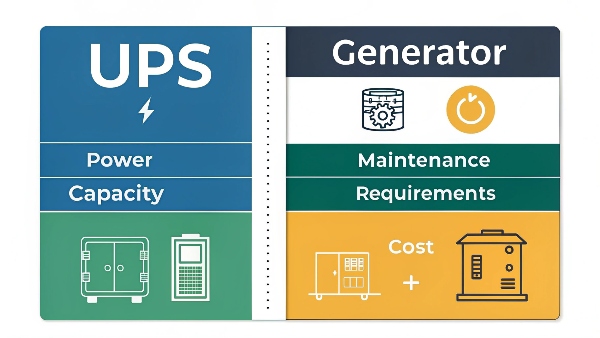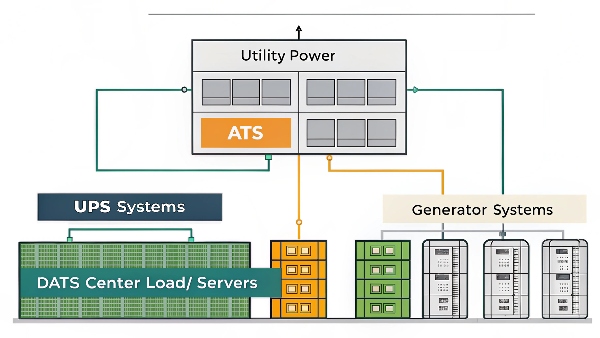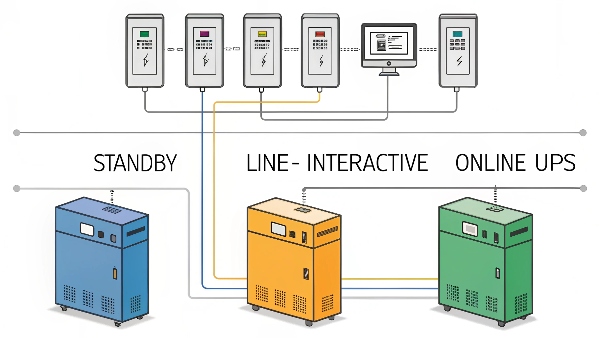Power outages halt business, costing money and trust. Worried about how to protect your critical systems effectively? Understand UPS vs. generators to choose the right solution.
UPS systems provide instant, short-term battery backup and power conditioning. Generators offer long-term power during extended outages but have a startup delay. They serve distinct but often complementary roles in ensuring continuous, clean power for critical operations.

Transition Paragraph:
These two power solutions are often discussed together, but they're not interchangeable. As someone who's been deep in the world of uninterruptible power supplies at Daopulse for a decade, I've seen firsthand how vital it is to understand their unique functions. My experience shows that UPS and generators serve different yet complementary roles in power protection. This understanding is key, especially for our clients like Mr. Li, a Procurement Manager ensuring hospital infrastructure reliability. Let's clarify their specific roles and how they can work together.
Do I need an UPS if I have a generator?
Generator takes time to start, leaving critical gear vulnerable. Relying solely on a generator risks data loss or damage. A UPS bridges that crucial gap, ensuring seamless protection.
Yes, you often need a UPS even with a generator. The UPS provides instant power during the generator's startup delay and conditions the generator's output, protecting sensitive electronics from interruptions or unstable power during the transition and operation.

Dive deeper Paragraph:
Many people believe a generator is the ultimate solution for power outages. While generators are fantastic for long-duration backup, they don't activate instantaneously. There's a startup period, typically lasting from several seconds to a minute or more, before the generator is ready to supply stable power. During this critical window, any connected equipment without a UPS will lose power. Imagine servers crashing or critical medical devices in a hospital shutting down. This is where a UPS is indispensable. At Daopulse, we design UPS systems, like our robust lead-acid models or our high-efficiency lithium battery solutions, specifically to cover this gap. The UPS batteries immediately take over, ensuring a continuous flow of power to your vital systems.
Furthermore, the power produced by a generator, especially when it first starts or if it's not a high-end inverter type, might not be perfectly "clean." It can have fluctuations in voltage or frequency. Sensitive electronics are susceptible to damage or malfunction from such irregularities. A good UPS, particularly an online double-conversion model, acts as a power conditioner. It takes the generator's output and refines it, delivering a pure sine wave to your equipment. This ensures that even when running on generator power, your devices receive stable and clean electricity, which is a key concern for our Procurement Manager clients sourcing for critical applications. So, the UPS isn't redundant; it's a crucial partner to the generator because UPS and generators serve different yet complementary roles in power protection.
| Feature | Generator Alone | UPS + Generator |
|---|---|---|
| Startup Time | Seconds to minutes delay | UPS provides instant power, no delay for load |
| Power Quality | Can be unstable, especially initially | UPS conditions/cleans generator power |
| Protection | For extended outages only | For sags, surges, brownouts, AND extended outages |
| Seamlessness | Power interruption during generator start-up | No interruption, seamless transition |
| Suitability | Good for robust, less sensitive loads | Essential for sensitive electronics, IT, medical |
What is the difference between UPS and generator data center?
Data centers demand absolute uptime, with no room for error. Confused how UPS and generators fit into this critical need? They form a layered defense, ensuring constant, clean power.
In a data center, a UPS provides instantaneous, conditioned power from batteries for short outages or until generators start. Generators offer long-term backup for extended outages. They are not alternatives but integral parts of a tiered power protection strategy for maximum uptime.

Dive deeper Paragraph:
In the context of a data center, UPS systems and generators are not an "either/or" choice; they are both essential components of a comprehensive power redundancy strategy, often referred to as N, N+1, or 2N redundancy. Data centers house critical IT infrastructure that cannot tolerate even a millisecond of downtime. The primary difference lies in their response time and duration of power supply. A UPS, like the industrial-grade systems we provide at Daopulse, offers immediate protection. When utility power fails, the UPS batteries instantly take over, ensuring that servers, storage, and network equipment continue to run seamlessly. This typically provides power for several minutes – enough time for the backup generators to start and stabilize.
Generators, on the other hand, are designed for long-duration power. Once the Automatic Transfer Switch (ATS) detects a sustained outage and the UPS is carrying the load, it signals the generators to start. After they are running reliably, the ATS transfers the data center's load to the generators. The generators can then power the facility for hours or even days, depending on fuel availability. The UPS also conditions the power from the generator, protecting sensitive IT equipment from fluctuations. This layered approach ensures that data centers meet their stringent Service Level Agreements (SLAs) for uptime. Our clients, System Integrators designing data center solutions, rely on this precise interplay. It truly shows how UPS and generators serve different yet complementary roles in power protection.
| Aspect | UPS in Data Center | Generator in Data Center |
|---|---|---|
| Response Time | Instantaneous (milliseconds) | Seconds to minutes |
| Duration | Short-term (minutes) | Long-term (hours to days) |
| Primary Function | Bridge power gap, power conditioning, surge protection | Provide backup power for extended outages |
| Power Quality | Conditions and cleans power (especially online UPS) | Output may need conditioning by UPS |
| Activation | Automatic on utility failure | Automatic start on utility failure, ATS transfers load |
| Fuel Source | Stored battery energy | Diesel, natural gas, etc. |
What are the three types of UPS systems?
Not all UPS systems offer the same level of protection. Choosing the wrong type can leave your equipment vulnerable. Learn the three main types to make an informed decision.
The three main types of UPS systems are Standby (or Offline), Line-Interactive, and Online (or Double-Conversion). They differ in how they interact with utility power and the level of protection and power conditioning they provide to connected equipment.

Dive deeper Paragraph:
Understanding the different types of UPS systems is crucial for selecting the right one for your needs. At Daopulse, we specialize in various UPS technologies, including both lead-acid and lithium battery options, catering to diverse applications from small offices to large data centers. I've guided many clients through this selection.
-
Standby (Offline) UPS:
- This is the most basic. Utility power passes directly to your devices. If power fails, it quickly switches to battery. It's simple and cost-effective.
- It mainly protects against full outages and some power surges. It doesn't improve power quality during normal operation.
- Good for home computers or basic office equipment that isn't too sensitive.
-
Line-Interactive UPS:
- This type is a step up. It manages small power dips and surges without using the battery, thanks to an internal transformer. It only uses the battery for bigger problems or full outages.
- It gives battery backup, surge protection, and smooths out minor power changes. Better for places with unstable power.
- Suitable for small servers, network gear, or more important workstations.
-
Online (Double-Conversion) UPS:
- This provides the best protection. It constantly converts incoming AC power to DC, then back to perfect AC power for your devices. Your equipment always runs on this clean, rebuilt power. There's no switchover delay if utility power fails.
- It guards against all common power issues: outages, sags, surges, noise, and frequency changes.
- Essential for critical systems like data center servers, hospital equipment, or any sensitive electronics where no interruption or power fluctuation is acceptable. Our patented technologies often enhance these online systems. This is the type we usually recommend when a generator is also involved.
| UPS Type | Power Path (Normal) | Transfer Time | Voltage Regulation | Power Conditioning | Cost |
|---|---|---|---|---|---|
| Standby (Offline) | Utility direct to load | 2-10 ms | No (or limited) | Basic (surges) | Low |
| Line-Interactive | Utility via transformer | 2-4 ms | Yes (buck/boost) | Moderate | Medium |
| Online (Double-Conv.) | Always via inverter | Zero | Precise | Highest | High |
How a UPS System Works with a Backup Generator?
Need both instant and long-term power protection? Wondering how these two systems collaborate without conflict? UPS and generator work in tandem for ultimate reliability.
A UPS provides immediate battery power during a utility failure, covering the generator's startup. Once the generator stabilizes, it takes over supplying long-term power to the facility and recharges the UPS, ensuring continuous, clean power for critical loads.

Dive deeper Paragraph:
The way a UPS system and a backup generator work together is a well-orchestrated sequence designed to ensure absolutely no interruption to the critical load. I've seen this partnership in action countless times, protecting everything from hospital equipment to extensive data center servers. It’s a core part of the reliable solutions we offer at Daopulse.
Here's the step-by-step:
- Normal Operation: Utility power flows. The UPS conditions this power (especially if it's an online model) and sends it to your devices, while keeping its batteries charged. The generator is off, waiting.
- Power Failure: The UPS instantly detects the outage. It immediately switches to its internal battery power. This happens so fast (milliseconds) that your equipment doesn't notice.
- Generator Starts: At the same time, an Automatic Transfer Switch (ATS) detects the utility failure1 and signals the generator to start. The generator needs a bit of time (seconds to a minute) to get up to speed and produce stable electricity. The UPS covers this gap. This clearly shows how UPS and generators serve different yet complementary roles in power protection.
- Transfer to Generator: Once the ATS confirms the generator is running stably, it switches the building's power source from the utility line to the generator.
- Generator Powering Load: The UPS now gets power from the generator2. It continues to condition this power for your devices and starts recharging its batteries.
- Utility Returns: When utility power is back and stable, the ATS switches the load back to the utility. The generator then cools down and shuts off. The UPS continues running on utility power. This synergy is what our clients needing maximum uptime depend on.
| Stage | UPS Action | Generator Action | ATS Action | Load Power Source |
|---|---|---|---|---|
| Utility Power ON | Conditions power, charges battery | Standby | Monitors utility | Utility (via UPS) |
| Utility Power FAILS | Switches to battery instantly | Receives start signal | Detects failure, signals generator | UPS Battery |
| Generator Starting Up | Powers load from battery | Ramps up to speed & stable output | Waits for stable generator power | UPS Battery |
| Generator Stable | (Awaiting transfer to draw from generator) | Signals readiness to ATS | Transfers load to generator | Generator (via UPS) |
| Extended Outage | Conditions generator power, recharges battery | Supplies power to facility & UPS | Maintains generator connection | Generator (via UPS) |
| Utility Power RESTORED | Switches to utility, continues charging/float | Receives stop signal after load transfer | Transfers load to utility, stops generator | Utility (via UPS) |
Conclusion
UPS systems offer instant, conditioned power; generators provide long-term backup. They differ in response and duration but together create a comprehensive, reliable power protection solution for any critical need.

